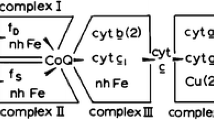Summary
Although abundant in most biological tissues and chemically well characterized, the fatty acid-binding protein (FABP) was until recently in search of a function. Because of its strong affinity for long chain fatty acids and its cytoplasmic origin, this protein was repeatedly claimed in the literature to be the transcytoplasmic fatty acid carrier. However, techniques to visualize and quantify the movements of molecules in the cytoplasm are still in their infancy. Consequently the carrier function of FABP remains somewhat speculative. However, FABP binds not only fatty acids but also their CoA and carnitine derivatives, two typical molecules of mitochondrial origin. Moreover, it has been demonstrated and confirmed that FABP is not exclusively cytoplasmic, but also mitochondrial. A function for FABP in the mitochondrial metabolism of fatty acids plus CoA and carnitine derivatives would therefore be anticpated. Using spin-labelling techniques, we present here evidence that FABP is a powerful regulator of acylcarnitine flux entering the mitochondrial β-oxidative system. In this perspective FABP appears to be an active link between the cytoplasm and the mitochondria, regulating the energy made available to the cell. This active participation of FABP is shown to be the consequence of its gradient-like distribution in the cardiac cell, and also of the coexistence of multispecies of this protein produced by self-aggregation.
Similar content being viewed by others
References
Opie LH: Metabolism of the heart in health and disease. Part I. Am Heart J 76: 685–698, 1968
Opie LH: Metabolism of the heart in health and disease. Part II. Am Heart J 77: 100–122, 1969
Opie LH: Metabolism of the heart in health and disease. Part III. Am Heart J 77: 383–410, 1969
Neely JR, Rovetto MJ, Oram JF: Myocardial utilization of carbohydrate and lipids. Prog Cardiovasc Dis 15: 289–329, 1972
Oram JF, Bennetch SL, Neely JR: Regulation of fatty acid utilization in isolated perfused rat hearts. J Biol Chem 248 (15):5299–5309,1973
Bremer J, Davis EJ: Phosphorylation coupled to acyl-coenzyme A dehydrogenase-linked oxidation of fatty acids by liver and heart mitochondria. Biochim-Biophys Acta 275: 298–301,1972
Pande SV: On rate-controlling factors of long chain fatty acid oxidation. J Biol Chem 246(17): 5384–5390, 1971
Fournier NC, Richard MA: Fatty acid-binding protein, a potential regulator of energy production in the heart. J Biol Chem 263(28): 14471–14479, 1988
Fournier NC, Rahim M: Control of energy production in the heart: a new function for fatty acid binding protein. Biochemistry 24: 2387–2396, 1985
Fournier NC, Zuker M, Williamse RE, Smith ICP: Selfassociation of the cardiac fatty acid binding protein. Influence on membrane-bound, fatty acid dependent enzymes. Biochemistry 22: 1863–1872, 1983
Reynolds ES: The use of lead citrate at high pH as an electron opaque stain in electron microscopy. J Cell Biol 17: 208–213,1963
Author information
Authors and Affiliations
Rights and permissions
About this article
Cite this article
Fournier, N.C., Richard, M.A. Role of fatty acid-binding protein in cardiac fatty acid oxidation. Mol Cell Biochem 98, 149–159 (1990). https://doi.org/10.1007/BF00231379
Issue Date:
DOI: https://doi.org/10.1007/BF00231379




